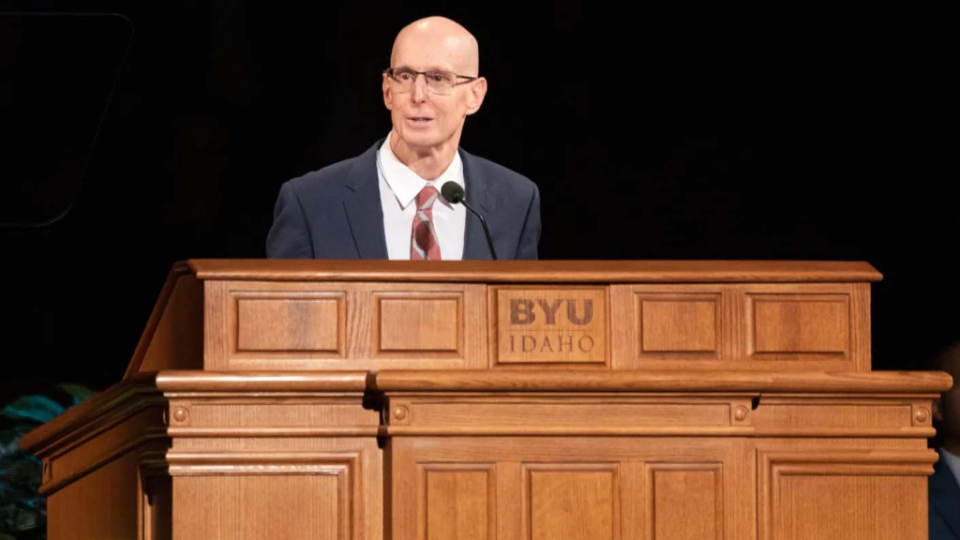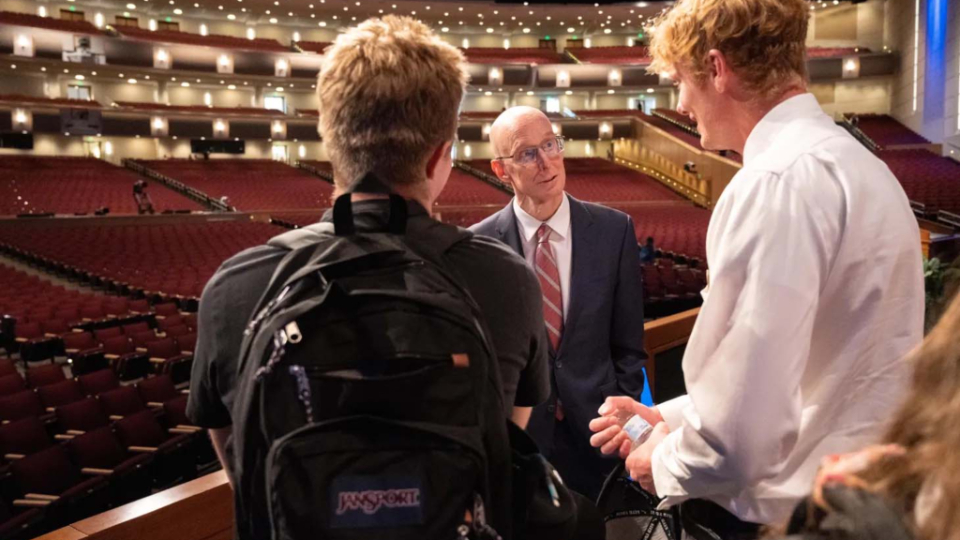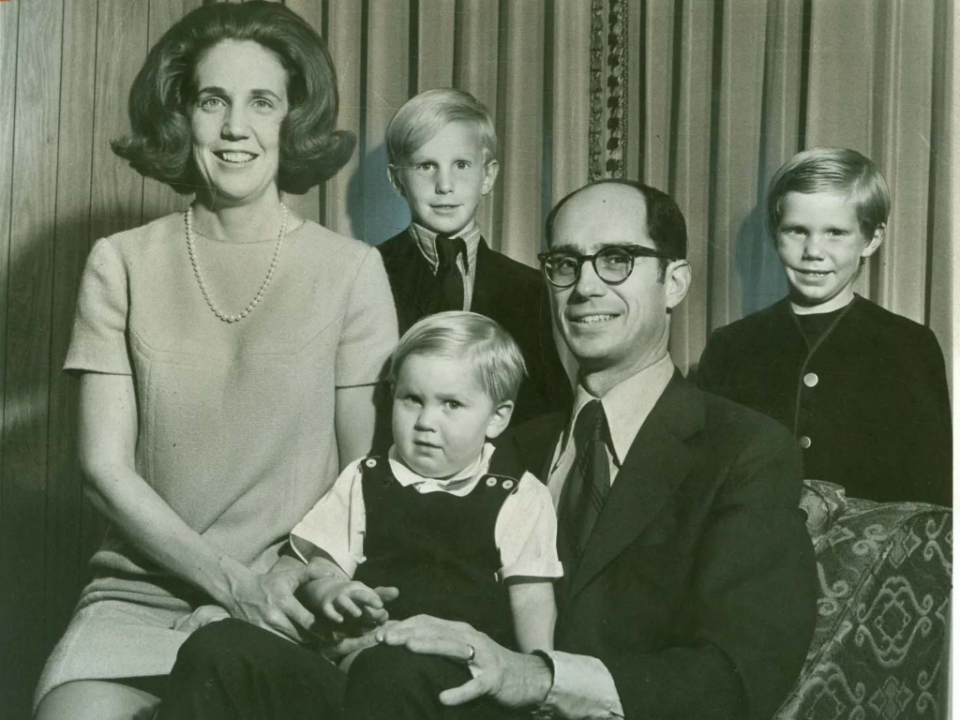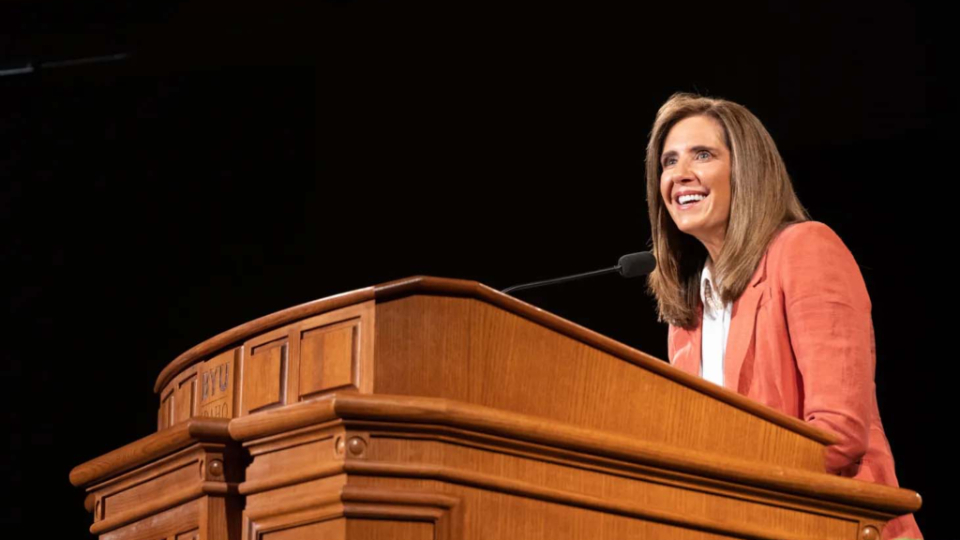
Henry-Eyring-BYU-Idaho-1
BYU–Idaho President Henry J. Eyring speaks at the first devotional of the fall semester September 13, 2022, at the campus in Rexburg, Idaho. Photo by Francisco Fierro, courtesy of Church News.All rights reserved.
This story appears here courtesy of TheChurchNews.com. It is not for use by other media.
By Trent Toone, Church News
Jacob Spori made many personal sacrifices as the first principal of what later became Brigham Young University–Idaho.
The Spori family spent a winter living in an unheated granary.
When some of the school’s early students paid tuition in the form of garden produce and others couldn’t pay, Spori reduced his already meager salary, worked on the railroad and shared his wages with other teachers.
The school survived because of Spori’s faith in the future, and because he lived a consecrated life, said BYU–Idaho President Henry J. Eyring during a BYU–Idaho devotional on Tuesday, September 13.

Henry-Eyring-BYU-Idaho-2
BYU-Idaho–President Henry J. Eyring speaks with students following the first devotional of the fall 2022 semester on September 13, 2022, at the campus in Rexburg, Idaho. Photo by Michael Lewis, courtesy of Church News.All rights reserved.
“We members and supporters of this prophetically led university can be united in the way that matters most: namely, living a life of consecration,” President Eyring said.
“We members of The Church of Jesus Christ of Latter-day Saints recognize the power of consecration in our lives. We can draw upon it personally. Like the prophets and other faithful Saints of the past, we can connect to divine revelation and power. In addition, we can lift others, becoming what the scriptures call ‘saviors on Mount Zion.’ With time and steady effort, our consecration can change the world for the better.”
Living a Consecrated Life
President Eyring expounded on the meaning of living a consecrated life by providing a series of examples of Latter-day Saints who lived consecrated lives.
In addition to Spori, President Eyring spoke of a family who developed a prosperous lumber and sawmill business. With growth and profits, the owner’s two diligent sons were tempted to cash out and make a fortune, but they resisted and let their holdings grow.
Years later, one of the sons walked into his bishop’s office and handed over a tithing check with a considerable sum. The bishop questioned the number of zeros on the check, but there was no mistake, the son said.
“There were not too many zeros — only several lifetimes of hard work, thrift and good financial investment,” President Eyring said. “The beneficiaries would be countless needy Saints.”
‘Beautiful Fruits of Consecration’
President Eyring said BYU–Idaho is “blessed with a consecrated faculty.” He invited Richard Pieper, a mathematics professor who will soon retire, to talk about an ancestor whose life demonstrated consecration.
Pieper told the story of Heinrich Friedrich Christian Pieper, his great-grandfather, who went by the name of Chris.
Chris Pieper joined the Church in Germany in 1895. He immigrated to Utah and eventually moved to Rexburg, Idaho, where he worked as a stonecutter and helped with the construction of the original Spori Building on campus.
Chris Pieper’s oldest son, Bill, was Richard Pieper’s grandfather. Bill and his wife were expecting their third child and money was scarce when Bill Pieper was called on a mission to Germany. He turned to his father for help to pay for his mission.

Henry-Eyring-BYU-Idaho-3
Richard Pieper, a BYU–Idaho mathematics professor, was a guest speaker during the first fall 2022 devotional on September 13, 2022, on the Rexburg, Idaho, campus. Photo by Michael Lewis, courtesy of Church News.All rights reserved.
Chris Pieper believed the Lord would bless him if he helped his son. He sent Bill Pieper to Salt Lake, then knelt in humble prayer.
“I petitioned Him to open the way that I might get work,” Chris Pieper wrote. “I must say that if I ever prayed earnestly before, I did it now, for I was against a stone wall, so to speak.”
Shortly thereafter, Chris Pieper was walking by a service station when a man there said he felt impressed to give him a job.
“I know my prayer was answered in getting work,” Chris Pieper wrote.
“The consecration of my great-grandfather, Chris, and my grandfather, Bill, and their good wives and families brought a power into their lives that can come in no other way,” Pieper said. “Their blessings and the blessings enjoyed by their posterity are the beautiful fruits of consecration. The Lord always keeps His promises to us.”
President Henry J. Eyring’s Parents
For President Eyring, two of the best examples of living a consecrated life have been his parents — his mother, Kathleen Johnson Eyring, and his father, President Henry B. Eyring, second counselor in the Church’s First Presidency.
In her younger days, Sister Eyring was active and outgoing. She loved learning and teaching while raising four boys.
“Above all else, though, Mother loved our Savior and His gospel,” her son said. “Learning and teaching the principles of the gospel was a lifelong passion.”

Henry-Eyring-BYU-Idaho-4
This photo shows a young President Henry B. Eyring, his wife, Kathleen, and their family before his inauguration as president of Ricks College in 1971. Their sons are Matthew, front, Henry and Stuart. President Eyring now serves as Second Counselor in the Church’s First Presidency.
There was a period of miscarriages and sadness, then two daughters joined the family. Sister Eyring adapted to raising the girls with new activities, including bread making, flower gardening and watercolor painting. When her health declined in later years, her husband has been there to care for her.
“President [Henry B.] Eyring has always known that he got the better half when marrying Mother,” his son said. ”She has personified consecration throughout her life, and Dad has stayed close, especially during this time in which she might shrink. There is no one more devoted to our Savior.”
An Invitation
President Henry J. Eyring closed his remarks with an invitation for all to live more consecrated lives.
“The key is to give our all to the giver of eternal life,” he said. “As we consecrate ourselves, He can lift us heavenward.”
Sister Hinckley’s ‘Unsolicited Advice’
As BYU–Idaho students embark on a new semester, Sister Kelly Eyring cited counsel and advice from Sister Marjorie Pay Hinckley, the wife of President Gordon B. Hinckley, who once delivered a talk she titled “Unsolicited, Unwelcome, and Unwanted Advice From a Seventy-Five-Year-Old Woman to College Students.” The full talk can be found in the appendix of Sister Hinckley’s 1999 book, ”Glimpses.”

Henry-Eyring-BYU-Idaho-5
Sister Kelly Eyring speaks at the first BYU–Idaho devotional of fall 2022 semester on Tuesday, September 13, 2022, in Rexburg, Idaho. Photo by Michael Lewis, courtesy of Church News.All rights reserved.
“I won’t be able to do it justice, but I hope you will enjoy Sister Hinckley’s counsel and apply her advice nonetheless,” Sister Eyring said. “Her advice is every bit as applicable to you as it was to her original audience.”
Sister Hinckley’s talk provided four suggestions for making your college days the best:
- Jump in with both feet.
- Develop friendships.
- Learn, learn, learn.
- Make religion an important part of your college life.
Sister Eyring also urged students to feed their spirits with gospel learning and to be an active member of their ward families.
“President Eyring and I will be praying for you and your success in the coming months,” she said.
Copyright 2022 Deseret News Publishing Company.